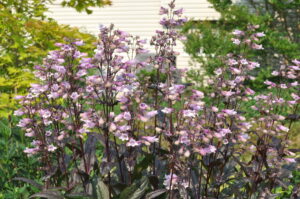Beardtongue (Penstemon)
* Common name: Beardtongue

Some varieties of penstemon have dark foliage in addition to the pollinator-attracting flowers. This one is Dakota Burgundy.
* Botanical name: Penstemon species
* What it is: Penstemon is a large family of summer-blooming perennials with tubular flowers that comes in assorted colors.
Most are U.S.-native species, including three versions local to south-central Pennsylvania: the white-blooming talus slope beardtongue (Penstemon digitalis) and the pinkish-violet hairy beardtongue (Penstemon hirsutus) and calico beardtongue (Penstemon calycosus).
The penstemon family comes in a variety of sizes – ranging from short groundcovers to five-foot-tall bushy plants – and blooms in a variety of shades, depending on species (most commonly white, pink, and purple/violet but also yellow, red, and burgundy).
Bees like the tubular flowers, which look a bit like foxglove flowers. June and July are the two peak months of bloom.
Deer usually don’t bother penstemon, but if they’re hungry enough and numerous enough, they may do some browsing.
‘Husker Red’ is a popular variety that has dark leaves, while the new Rock Candy and Dakota series have performed well in trials at Penn State’s Trial Garden in Lancaster County.
* Size: Depending on species, plants range from one to five feet tall. Space plants 18 to 24 inches apart.
* Where to use: Penstemon flowers best in full sun locations with well drained soil. Avoid wet and clayish sites. Most penstemons are heat- and drought-tough and do well in sunny perennial gardens, in sunny meadows, and in south- and west-facing foundation beds. It’s also a natural in a pollinator garden.
* Care: Keep damp the first season, then water usually is not needed except in extended dry spells.
Scatter an organic granular fertilizer formulated for flowers over the bed in early spring.
Snip off flower stems after bloom, then cut back foliage to the ground at the end of winter.
Divide in early spring or after bloom in early fall if clumps are spreading beyond where you want.
* Great partner: Mix with other sun-loving natives in a perennial or pollinator garden, such as purple coneflowers, agastache, asters, baptisia, tall garden phlox, and New York ironweed. Penstemon also pairs well with ornamental grasses such as switchgrass and little bluestem.







